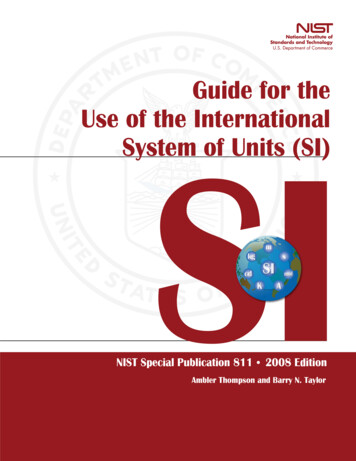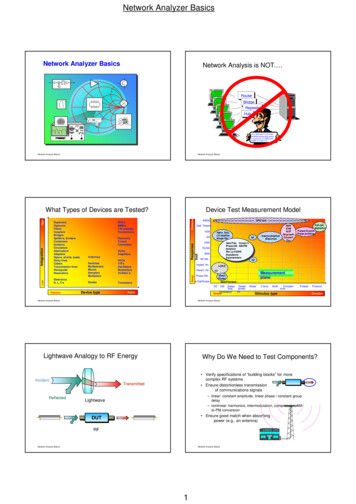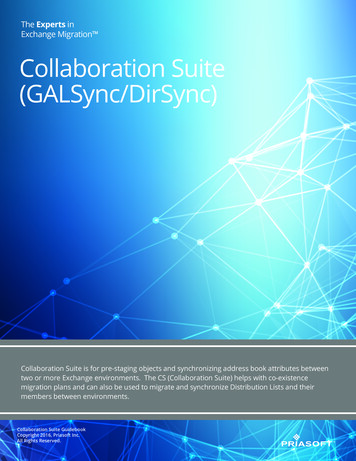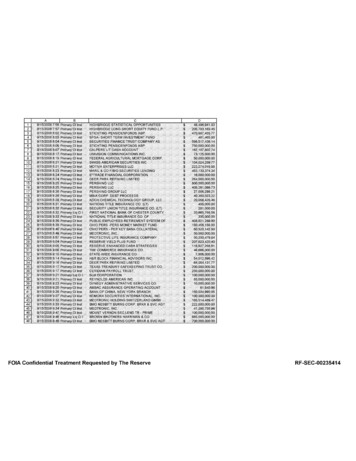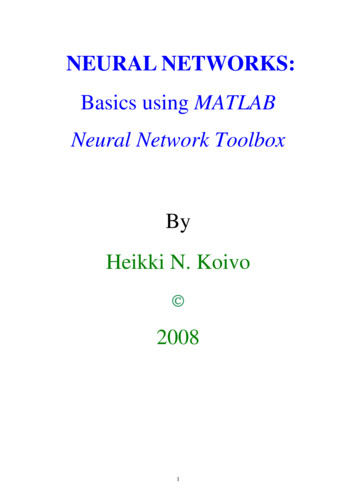
Transcription
NEURAL NETWORKS:Basics using MATLABNeural Network ToolboxByHeikki N. Koivo 20081
Heikki Koivo @ February 1, 2008-2–Neural networks consist of a large class of different architectures. In manycases, the issue is approximating a static nonlinear, mapping f ( x ) with aneural network f NN ( x ) , where x R K .The most useful neural networks in function approximation are MultilayerLayer Perceptron (MLP) and Radial Basis Function (RBF) networks. Here weconcentrate on MLP networks.A MLP consists of an input layer, several hidden layers, and an output layer.Node i, also called a neuron, in a MLP network is shown in Fig. 1. It includesa summer and a nonlinear activation function g.x1x2xKw1iw2i.wKi K yi gi g w ji x j θi j 1 g ( ni )Kni w ji x j θiΣj 1θiFig. 1. Single node in a MLP network.The inputs xk , k 1,., K to the neuron are multiplied by weights wki andsummed up together with the constant bias term θi . The resulting ni is theinput to the activation function g. The activation function was originallychosen to be a relay function, but for mathematical convenience a hyberbolictangent (tanh) or a sigmoid function are most commonly used. Hyberbolictangent is defined astanh( x ) 1 e x1 e x(1)The output of node i becomes K yi gi g w ji x j θi j 1 (2)Connecting several nodes in parallel and series, a MLP network is formed. Atypical network is shown in Fig. 2.2
Input layerHidden layerOutput layerFig. 2. A multilayer perceptron network with one hidden layer. Here the sameactivation function g is used in both layers. The superscript ofn, θ , or w refers to the layer, first or second.The output yi , i 1, 2, of the MLP network becomes 3 3 K yi g w2ji g (n1j ) θ j2 g w2ji g w1kj xk θ 1j θ j2 k 1 j 1 j 1 (3)From (3) we can conclude that a MLP network is a nonlinear parameterizedmap from input space x R K to output space y R m (here m 3). Theparameters are the weights wkji and the biases θ jk . Activation functions g areusually assumed to be the same in each layer and known in advance. In thefigure the same activation function g is used in all layers.Given input-output data ( xi , yi ) , i 1,., N , finding the best MLP network isformulated as a data fitting problem. The parameters to be determined are( wkji ,θ jk ) .The procedure goes as follows. First the designer has to fix the structure of theMLP network architecture: the number of hidden layers and neurons (nodes)in each layer. The activation functions for each layer are also chosen at thisstage, that is, they are assumed to be known. The unknown parameters to beestimated are the weights and biases, ( wkji ,θ jk ) .3
Many algorithms exist for determining the network parameters. In neuralnetwork literature the algorithms are called learning or teaching algorithms, insystem identification they belong to parameter estimation algorithms. Themost well-known are back-propagation and Levenberg-Marquardt algorithms.Back-propagation is a gradient based algorithm, which has many variants.Levenberg-Marquardt is usually more efficient, but needs more computermemory. Here we will concentrate only on using the algorithms.Summarizing the procedure of teaching algorithms for multilayer perceptronnetworks:a. The structure of the network is first defined. In the network,activation functions are chosen and the network parameters, weightsand biases, are initialized.b. The parameters associated with the training algorithm like errorgoal, maximum number of epochs (iterations), etc, are defined.c. The training algorithm is called.d. After the neural network has been determined, the result is firsttested by simulating the output of the neural network with themeasured input data. This is compared with the measured outputs.Final validation must be carried out with independent data.The MATLAB commands used in the procedure are newff, train and sim.The MATLAB command newff generates a MLPN neural network, which iscalled net.net newff ( NPR ,[ S1 S 2.SNl ],{ TFBTF ) 1 TF 2.TFNl }, Nmin,maxvaluessize of the ith layeractivation function of ith layer(4)trainingalgorithmThe inputs in (4) areRxRSiNlTFiBTF Number of elements in input vector Rx2 matrix of min and max values for R input elements, Number of neurons (size) in the ith layer, i 1, ,Nl Number of layers Activation (or transfer function) of the ith layer, default 'tansig', Network training function, default 'trainlm'In Fig. 2 R K, S1 3, S2 2, Nl 2 and TFi g.The default algorithm of command newff is Levenberg-Marquardt, trainlm.Default parameter values for the algorithms are assumed and are hidden fromthe user. They need not be adjusted in the first trials. Initial values of theparameters are automatically generated by the command. Observe that theirgeneration is random and therefore the answer might be different if thealgorithm is repeated.4
After initializing the network, the network training is originated using traincommand. The resulting MLP network is called net1.net1 train( netN,Nx,Ny)(5)initial measuredmeasuredMLP input vector output vectorThe arguments are: net, the initial MLP network generated by newff, x,measured input vector of dimension K and y measured output vector ofdimension m.To test how well the resulting MLP net1 approximates the data, sim commandis applied. The measured output is y. The output of the MLP network issimulated with sim command and called ytest.ytest sim(netN1, Nx )finalMLP(6)înputvectorThe measured output y can now be compared with the output of the MLPnetwork ytest to see how good the result is by computing the error difference e y – ytest at each measured point. The final validation must be done withindependent data.In the following a number of examples are covered, where MATLAB NeuralNetwork Toolbox is used to learn the parameters in the network, when inputoutput data is available.5
NEURAL NETWORKS - EXERCISESWITH MATLAB AND SIMULINKBASIC FLOW DIAGRAMCREATE A NETWORK OBJECTAND INITIALIZE ITUse command newff*TRAIN THE NETWORKUse command train(batch training)TO COMPARE RESULTS COMPUTETHE OUTPUT OF THE NETWORKWITH TRAINING DATA ANDVALIDATION DATAUse command sim*The command newff both defines the network (type of architecture, size andtype of training algorithm to be used). It also automatically initializes thenetwork. The last two letters in the command newff indicate the type of neuralnetwork in question: feedforward network. For radial basis function networksnewrb and for Kohonen’s Self-Organizing Map (SOM) newsom are used.6
Before starting with the solved exercises, it is a good idea to study MATLAB NeuralNetwork Toolbox demos. Type demo on MATLAB Command side and the MATLABDemos window opens. Choose Neural Networks under Toolboxes and study thedifferent windows.7
EXAMPLE 1: Consider humps function in MATLAB. It is given byy 1 ./ ((x-.3). 2 .01) 1 ./ ((x-.9). 2 .04) - 6;but in MATLAB can be called by humps. Here we like to see if it is possible to find a neural networkto fit the data generated by humps-function between [0,2].a) Fit a multilayer perceptron network on the data. Try different network sizes and different teachingalgorithms.b) Repeat the exercise with radial basis function networks.SOLUTION: To obtain the data use the following commandsx 0:.05:2; y humps(x);P x; T y;Plot the dataplot(P,T,'x')grid; xlabel('time (s)'); ylabel('output'); title('humps function')The teaching algorithms for multilayer perceptron networks have the following structure:e. Define the structure of the network. Choose activation functions and initialize theneural network parameters, weights and biases, either providing them yourself orusing initializing routines.MATLAB command for MLPN initialization is newff.f. Define the parameters associated with the training algorithm like error goal,maximum number of epochs (iterations), etc.g. Call the ttraining algorithm. In MATLAB the command is train.% DESIGN THE NETWORK% %First try a simple one – feedforward (multilayer perceptron) networknet newff([0 2], [5,1], {'tansig','purelin'},'traingd');% Here newff defines feedforward network architecture.8
% The first argument [0 2] defines the range of the input and initializes the network parameters.% The second argument the structure of the network. There are two layers.% 5 is the number of the nodes in the first hidden layer,% 1 is the number of nodes in the output layer,% Next the activation functions in the layers are defined.% In the first hidden layer there are 5 tansig functions.% In the output layer there is 1 linear function.% ‘learngd’ defines the basic learning scheme – gradient method% Define learning parametersnet.trainParam.show 50; % The result is shown at every 50th iteration (epoch)net.trainParam.lr 0.05; % Learning rate used in some gradient schemesnet.trainParam.epochs 1000; % Max number of iterationsnet.trainParam.goal 1e-3; % Error tolerance; stopping criterion%Train networknet1 train(net, P, T); % Iterates gradient type of loop% Resulting network is strored in net1TRAINGD, Epoch 0/1000, MSE 765.048/0.001, Gradient 69.9945/1e-010 .TRAINGD, Epoch 1000/1000, MSE 28.8037/0.001, Gradient 33.0933/1e-010TRAINGD, Maximum epoch reached, performance goal was not met.The goal is still far away after 1000 iterations (epochs).REMARK 1: If you cannot observe exactly the same numbers or the same performance, this isnot surprising. The reason is that newff uses random number generator in creating the initialvalues for the network weights. Therefore the initial network will be different even when exactlythe same commands are used.Convergence is shown below.9
It is also clear that even if more iterations will be performed, no improvement is in store. Let us stillcheck how the neural network approximation looks like.% Simulate how good a result is achieved: Input is the same input vector P.% Output is the output of the neural network, which should be compared with output dataa sim(net1,P);% Plot result and compareplot(P,a-T, P,T); grid;10
The fit is quite bad, especially in the beginning. What is there to do? Two things are apparent. With allneural network problems we face the question of determining the reasonable, if not optimum, size ofthe network. Let us make the size of the network bigger. This brings in also more network parameters,so we have to keep in mind that there are more data points than network parameters. The other thing,which could be done, is to improve the training algorithm performance or even change the algorithm.We’ll return to this question shortly.Increase the size of the network: Use 20 nodes in the first hidden layer.net newff([0 2], [20,1], {'tansig','purelin'},'traingd');Otherwise apply the same algorithm parameters and start the training process.net.trainParam.show 50; % The result is shown at every 50th iteration (epoch)net.trainParam.lr 0.05; % Learning rate used in some gradient schemesnet.trainParam.epochs 1000; % Max number of iterationsnet.trainParam.goal 1e-3; % Error tolerance; stopping criterion%Train networknet1 train(net, P, T); % Iterates gradient type of loopTRAINGD, Epoch 1000/1000, MSE 0.299398/0.001, Gradient 0.0927619/1e-010TRAINGD, Maximum epoch reached, performance goal was not met.The error goal of 0.001 is not reached now either, but the situation has improved significantly.From the convergence curve we can deduce that there would still be a chance to improve the networkparameters by increasing the number of iterations (epochs). Since the backpropagation (gradient)algorithm is known to be slow, we will try next a more efficient training algorithm.Try Levenberg-Marquardt – trainlm. Use also smaller size of network – 10 nodes in the first hiddenlayer.net newff([0 2], [10,1], {'tansig','purelin'},'trainlm');11
%Define parametersnet.trainParam.show 50;net.trainParam.lr 0.05;net.trainParam.epochs 1000;net.trainParam.goal 1e-3;%Train networknet1 trainlm(net, P, T);TRAINLM, Epoch 0/1000, MSE 830.784/0.001, Gradient 1978.34/1e-010 .TRAINLM, Epoch 497/1000, MSE 0.000991445/0.001, Gradient 1.44764/1e-010TRAINLM, Performance goal met.The convergence is shown in the figure.Performance is now according to the tolerance specification.%Simulate resulta sim(net1,P);%Plot the result and the errorplot(P,a-T,P,T)xlabel('Time (s)'); ylabel('Output of network and error'); title('Humps function')12
It is clear that L-M algorithm is significantly faster and preferable method to back-propagation.Note that depending on the initialization the algorithm converges slower or faster.There is also a question about the fit: should all the dips and abnormalities be taken into account or arethey more result of poor, noisy data.When the function is fairly flat, then multilayer perception network seems to have problems.Try simulating with independent data.x1 0:0.01:2; P1 x1;y1 humps(x1); T1 y1;a1 sim(net1,P1);plot(P1,a-a1,P1,T1,P,T)If in between the training data points are used, the error remains small and we cannot see very muchdifference with the figure above.Such data is called test data. Another observation could be that in the case of a fairly flat area, neuralnetworks have more difficulty than with more varying data.b) RADIAL BASIS FUNCTION NETWORKSHere we would like to find a function, which fits the 41 data points using a radial basis network.A radial basis network is a network with two layers. It consists of a hidden layer of radial basisneurons and an output layer of linear neurons.Here is a typical shape of a radial basis transfer function used by the hidden layer:p -3:.1:3;a radbas(p);plot(p,a)13
The weights and biases of each neuron in the hidden layer define the position and width of a radialbasis function.Each linear output neuron forms a weighted sum of these radial basis functions. With the correctweight and bias values for each layer, and enough hidden neurons, a radial basis network can fit anyfunction with any desired accuracy.We can use the function newrb to quickly create a radial basis network, which approximates thefunction at these data points.From MATLAB help command we have the following description of the algorithm.Initially the RADBAS layer has no neurons. The following stepsare repeated until the network's mean squared error falls below GOAL.1) The network is simulated2) The input vector with the greatest error is found3) A RADBAS neuron is added with weights equal to that vector.4) The PURELIN layer weights are redesigned to minimize error.Generate data as beforex 0:.05:2; y humps(x);P x; T y;The simplest form of newrb command isnet1 newrb(P,T);For humps the network training leads to singularity and therefore difficulties in training.Simulate and plot the resulta sim(net1,P);plot(P,T-a,P,T)14
The plot shows that the network approximates humps but the error is quite large. The problem is thatthe default values of the two parameters of the network are not very good. Default values are goal mean squared error goal 0.0, spread - spread of radial basis functions 1.0.In our example choose goal 0.02 and spread 0.1.goal 0.02; spread 0.1;net1 newrb(P,T,goal,spread);Simulate and plot the resulta sim(net1,P);plot(P,T-a,P,T)xlabel('Time (s)'); ylabel('Output of network and error');title('Humps function approximation - radial basis function')15
This choice will lead to a very different end result as seen in the figure.QUESTION: What is the significance of small value of spread. What about large?The problem in the first case was too large a spread (default 1.0), which will lead to too sparse asolution. The learning algorithm requires matrix inversion and therefore the problem with singularity.By better choice of spread parameter result is quite good.Test also the other algorithms, which are related to radial base function or similar networks NEWRBE,NEWGRNN, NEWPNN.EXAMPLE 2. Consider a surface described by z cos (x) sin (y) defined on a square 2 x 2, 2 y 2.a) Plot the surface z as a function of x and y. This is a demo function in MATLAB, so you can also findit there.b) Design a neural network, which will fit the data. You should study different alternatives and test thefinal result by studying the fitting error.SOLUTIONGenerate datax -2:0.25:2; y -2:0.25:2;z cos(x)'*sin(y);Draw the surface (here grid size of 0.1 has been used)mesh(x,y,z)xlabel('x axis'); ylabel('y axis'); zlabel('z axis');title('surface z cos(x)sin(y)');gi input('Strike any key .');16
pauseStore data in input matrix P and output vector TP [x;y]; T z;Use a fairly small number of neurons in the first layer, say 25, 17 in the output.Initialize the networknet newff([-2 2; -2 2], [25 17], {'tansig' 'purelin'},'trainlm');Apply Levenberg-Marquardt algorithm%Define parametersnet.trainParam.show 50;net.trainParam.lr 0.05;net.trainParam.epochs 300;net.trainParam.goal 1e-3;%Train networknet1 train(net, P, T);gi input('Strike any key .');TRAINLM, Epoch 0/300, MSE 9.12393/0.001, Gradient 684.818/1e-010TRAINLM, Epoch 3/300, MSE 0.000865271/0.001, Gradient 5.47551/1e-010TRAINLM, Performance goal met.Plot how the error develops17
Simulate the response of the neural network and draw the corresponding surfacea sim(net1,P);mesh(x,y,a)The result looks satisfactory, but a closer examination reveals that in certain areas the approximation isnot so good. This can be seen better by drawing the error surface.18
% Error surfacemesh(x,y,a-z)xlabel('x axis'); ylabel('y axis'); zlabel('Error'); title('Error surface')gi input('Strike any key to continue.');% Maximum fitting errorMaxfiterror max(max(z-a))Maxfiterror 0.1116Depending on the computing power of your computer the error tolerance can be made stricter, say 10-5.The convergence now takes considerably more time and is shown below.19
Producing the simulated results gives the following results20
EXAMPLE 3: Consider Bessel functions Jα(t), which are solutions of the differential equationt 2 y ty (t 2 α 2 ) y 0 .Use backpropagation network to approximate first order Bessel function J1 , α 1, when ta) Plot J1(t).b) Try different structures to for fitting. Start with a two-layer network.You might also need different learning algorithms.SOLUTION:1. First generate the data.MATLAB has Bessel functions as MATLAB functions.t 0:0.1:20; y bessel(1,t);plot(t,y)gridxlabel('time in secs');ylabel(‘y’); title('First order bessel function');21 [0,20].
2. Next try to fit a backpropagation network on the data. Try Levenberg-Marquardt.P t; T y;%Define network. First try a simple onenet newff([0 20], [10,1], {'tansig','purelin'},'trainlm');%Define parametersnet.trainParam.show 50;net.trainParam.lr 0.05;net.trainParam.epochs 300;net.trainParam.goal 1e-3;%Train networknet1 train(net, P, T);TRAINLM, Epoch 0/300, MSE 11.2762/0.001, Gradient 1908.57/1e-010TRAINLM, Epoch 3/300, MSE 0.000417953/0.001, Gradient 1.50709/1e-010TRAINLM, Performance goal met.22
% Simulate resulta sim(net1,P);%Plot result and compareplot(P,a,P,a-T)xlabel('time in secs');ylabel('Network output and error');title('First order bessel function'); gridSince the error is fairly significant, let’s reduce it by doubling the nodes in the first hidden layer to 20and decreasing the error tolerance to 10-4.The training is over in 8 iterationsTRAINLM, Epoch 0/300, MSE 4.68232/0.0001, Gradient 1153.14/1e-010TRAINLM, Epoch 8/300, MSE 2.85284e-005/0.0001, Gradient 0.782548/1e-010TRAINLM, Performance goal met.After plotting this results in the following figure.23
The result is considerably better, although it would still require improvement. This is left as furtherexercise to the reader.EXAMPLE 4: Study, if it is possible to find a neural network model, which produces the samebehavior as Van der Pol equation. x ( x 2 1) x x 0or in state-space formx 1 x2 (1 x12 ) x1x 2 x1Use different initial functions.Apply vector notationx f(x)where x f ( x , x ) x (1 x12 ) x1 x 1 and f (x) 1 1 2 2 x1 x2 f 2 ( x1 , x 2 ) SOLUTION:First construct a Simulink model of Van der Pol system. It is shown below. Call it vdpol.24
Recall that initial conditions can be defined by opening the integrators. For example the initialcondition x1(0) 2 is given by opening the corresponding integrator.Use initial condition x1(0) 1, x2(0) 1.% Define the simulation parameters for Van der Pol equation% The period of simulation: tfinal 10 seconds;tfinal 10;% Solve Van der Pol differential equation[t,x] sim('vdpol',tfinal);% Plot the states as function of timeplot(t,x)xlabel(‘time (secs)'); ylabel('states x1 and x2'); title('Van Der Pol'); gridgi input(Strike any key .');25
%Plot also the phase plane plotplot(x(:,1),x(:,2)), title('Van Der Pol'),gridgi input(Strike any key .');% Now you have data for one trajectory, which you can use to teach a neural network% Plot the data (solution). Observe that the output vector includes bothP t';T x';plot(P,T,' ');title('Training Vectors');xlabel('Input Vector P');ylabel('Target Vector T');gi input('Strike any key .');26
% Define the learning algorithm parameters, radial basis function network chosennet newff([0 20], [10 2], {'tansig','purelin'},'trainlm');%Define parametersnet.trainParam.show 50;net.trainParam.lr 0.05;net.trainParam.epochs 1000;net.trainParam.goal 1e-3;%Train networknet1 train(net, P, T);gi input(' Strike any key.');TRAINLM, Epoch 0/300, MSE 4.97149/0.001, Gradient 340.158/1e-010TRAINLM, Epoch 50/300, MSE 0.0292219/0.001, Gradient 0.592274/1e-010TRAINLM, Epoch 100/300, MSE 0.0220738/0.001, Gradient 0.777432/1e-010TRAINLM, Epoch 150/300, MSE 0.0216339/0.001, Gradient 1.17908/1e-010TRAINLM, Epoch 200/300, MSE 0.0215625/0.001, Gradient 0.644787/1e-010TRAINLM, Epoch 250/300, MSE 0.0215245/0.001, Gradient 0.422469/1e-010TRAINLM, Epoch 300/300, MSE 0.0215018/0.001, Gradient 0.315649/1e-010TRAINLM, Maximum epoch reached, performance goal was not met.27
The network structure is too simple, since convergence is not achieved. Let’s see how close thenetwork solution is to the simulated solution.%Simulate resulta sim(net1,P);%Plot the result and the errorplot(P,a,P,a-T)gi input('Strike any key.');The result is not very good, so let’s try to improve it.Using 20 nodes in the hidden layer gives a much better result.28
Try to further improve the multilayer perceptron solution.Use next radial basis function network with spread 0.01.net1 newrb(P,T,0.01);%Simulate resulta sim(net1,P);%Plot the result and the errorplot(P,a-T,P,T)The result is displayed in the following figure.29
The result is comparable with the previous one.Try also other initial conditions. If x1(0) 2, and another net is fitted, with exactly the same procedure,the result is shown in the following figure.It is apparent that for a new initial condition, a new neural network is needed to approximate the result.This is neither very economic nor practical procedure. In example 6, a more general procedure ispresented, which is often called hybrid model. The right-hand side of the state equation, or part of it, isapproximated with a neural network and the resulting, approximating state-space model is solved.30
EXAMPLE 5. Solve linear differential equation in the interval [0, 10]. x 0.7 x 1.2 x u (t )when u(t) is a unit step. The initial conditions are assumed to be zero. Assume also that the step takesplace at t 0 s. (In Simulink the default value is 1 s.). The output x(t) is your data.Fit multilayer perceptron and radial basis function networks on the data and compare the result withthe original data. Add noise to the data and do the fit. Does neural network filter data?SOLUTION: Set up the SIMULINK configuration for the system. Call it linearsec. In simulation usefixed step, because then the number of simulation points remains in better control. If variable-stepmethods are used, automatic step-size control usually generates more data points than you want.Go to MATLAB Command window. Simulate and plot the result.[t1,x1] sim('linsec',20);plot(t1,x1(:,2))xlabel(' t in secs');ylabel('output y'); title('Step response of a linear, second order system');grid31
Now you have input-output data [t,y]. Proceed as in the previous examples. Here only radial basisfunctions are used.P t1';T x1(:,2)';plot(P,T,'r ');title('Training Vectors');xlabel('Input Vector P');ylabel('Target Vector T');gi input('Strike any key .');Number of simulation data points and size of the networks should be carefully considered.Complete the exercise.32
EXAMPLE 6: Simulate the hybrid system x x f (x)for different initial conditions. Function y f(x) is has been measured and you must first fit a neuralnetwork on the data. Use both backpropagation and radial basis function networks. The data isgenerated using y f(x) ad of typing the data generate it with the following SIMULINK model shown below.33
When you use workspace blocks, choose Matrix Save format. Open To workspace block and chooseMatrix in the Menu and click OK. In this way the data is available in Command side.The simulation parameters are chosen from simulation menu given below, fixed-step method, step size 0.2. Observe also the start and stop times. SIMULINK can be used to generate handily data. Thiscould also be done on the command side. Think of how to do it.34
SOLUTION:Define the input and output data vectors for the neural networks.P x;T nonlin;plot(P,T,' ')title('Nonlinear mapping');xlabel('Input Vector P');ylabel('Output vector T');grid;gi input('Strike any key .');% LEVENBERG-MARQUARDT:net newff([-6 6], [20,1], {'tansig','purelin'},'trainlm');35
%Define parametersnet.trainParam.show 50;net.trainParam.lr 0.05;net.trainParam.epochs 500;net.trainParam.goal 1e-3;%Train networknet1 train(net, P, T);TRAINLM, Epoch 0/500, MSE 15.6185/0.001, Gradient 628.19/1e-010TRAINLM, Epoch 3/500, MSE 0.000352872/0.001, Gradient 0.0423767/1e-010TRAINLM, Performance goal met.The figure below shows convergence. The error goal is reached.The result of the approximation by multilayer perceptron network is shown below together with theerror.a sim(net1,P); plot(P,a,P,a-T,P,T)xlabel(‘Input x’);ylabel(‘Output y’);title(‘Nonlinear function f(x)’)36
There is still some error, but let us proceed. Now we are ready to tackle the problem of solving thehybrid problem in SIMULINK. In order to move from the command side to SIMULINK use commandgensim. This will transfer the information about the neural network to SIMULINK and at the sametime it automatically generates a SIMULINK file with the neural network block. The second argumentis used to define sampling time. For continuous sampling the value is –1.gensim(net1,-1)If you open the Neural Network block, you can see more details.37
Open Layer 1. You’ll see the usual block diagram representation of Neural Network Toolbox. In ourexamples, Delays block is unity map, i.e., no delays are in use.Open also the weight block. The figure that you see is shown below. The number of nodes has beenreduced to 5, so that the figure fits on the page. In the example we have 20.38
To convince ourselves that the block generated with gensim really approximates the given data, we’llfeed in values of x in the range [-5,5]. Use the following SIMULINK configuration.39
Now simulate the system.40
The result is plotted below.plot(tout,yout,tout,yhybrid)title('Nonlinear system'); xlabel('Time in secs');ylabel('Output of the real system and the hybrid system'); grid;Careful study shows that some error remains. Further improvement can be obtained either by addingthe network size or e.g. tightening the error tolerance bound.41
If the data is noise corrupted the procedure is the same, except that it is recommended that datapreprocessing is performed. The data is shown below.The following SIMULINK model shown below is configured to simulate noise-corrupted data.42
The result of the approximation by multilayer perceptron network is shown below together with theerror.As can be seen in the figure, there is still error, but since the given data is noisy, we are reasonablyhappy with the fit. Preprocessing of data, using e.g. filtering, should be carried out before neuralnetwork fitting.Now we are ready to tackle the problem of solving the hybrid problem in SIMULINK. Again usecommand gensim.gensim(net1,-1)43
REMARK: The other way to set up your own neural network from the blocks is to look underBlocksets & Toolboxes.The basic blocks can be found in the three block libraries: Transfer Functions, Net Input Functions andWeight Functions. Parameters for the blocks have to be generated in the Command window. Then theSIMULINK configuration is performed. This seems to be quite tedious and the added freedom doesnot seem to be worth the trouble. Perhaps, in the coming versions of the Toolbox, a more user-friendlyand flexible GUI is provided. Currently, the use of gensim command is recommended.44
To convince ourselves that the block generated with gensim really approximates the given data, we’llfeed in values of x in the range [-6,6]. Use the following SIMULINK configuration for comparison.The result is quite satisfactory.Now simulate the system.45
Simulation result looks quite reasonable.46
PROBLEM 1. Function approximation.a.Generate by whatever means input data for the functiony ( x) x 2 3xwhen 4 x 4.b. Plot the data.c. Fit multilayer perceptron and
Before starting with the solved exercises, it is a good idea to study MATLAB Neural Network Toolbox demos. Type demo on MATLAB Command side and the MATLAB Demos window opens. Choose Neural



